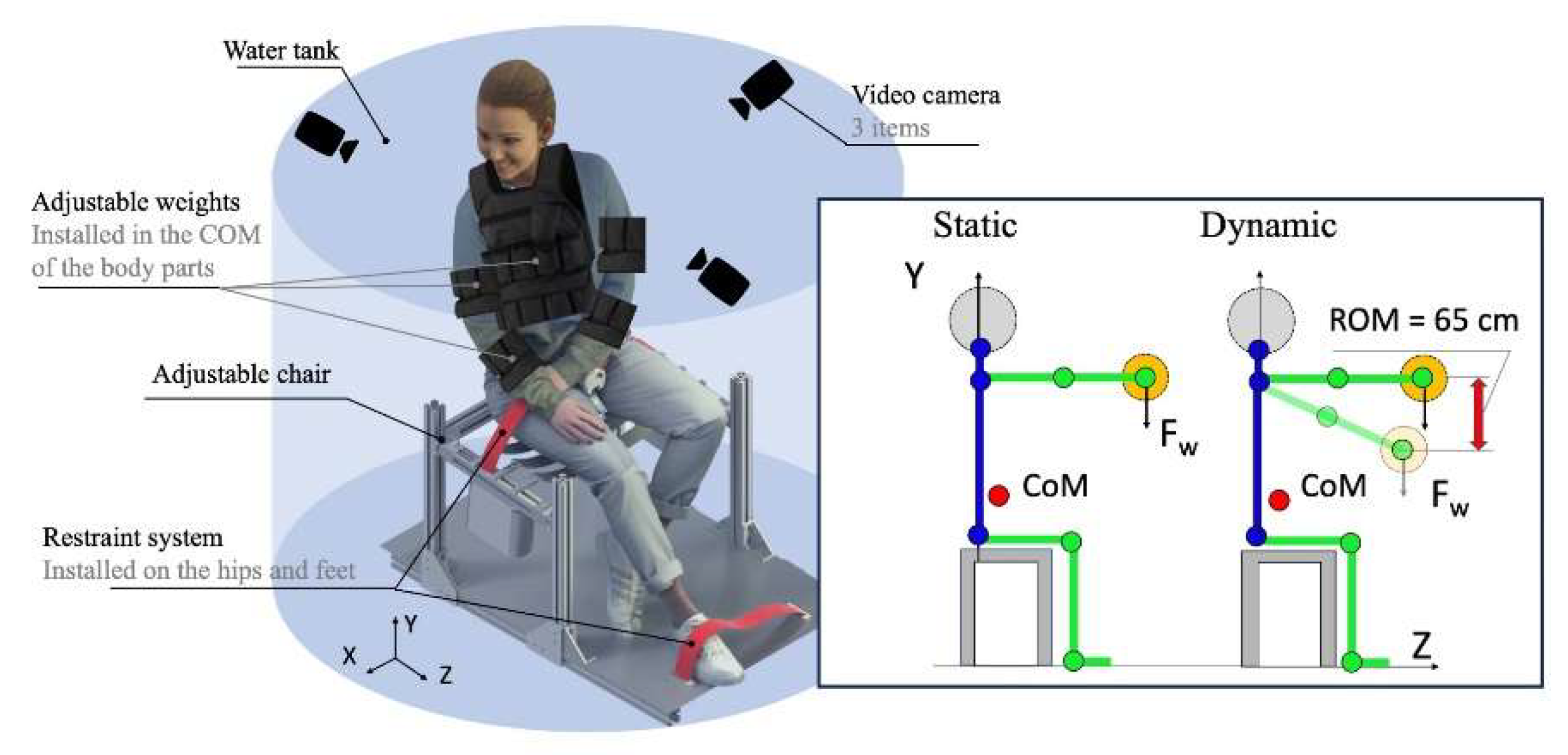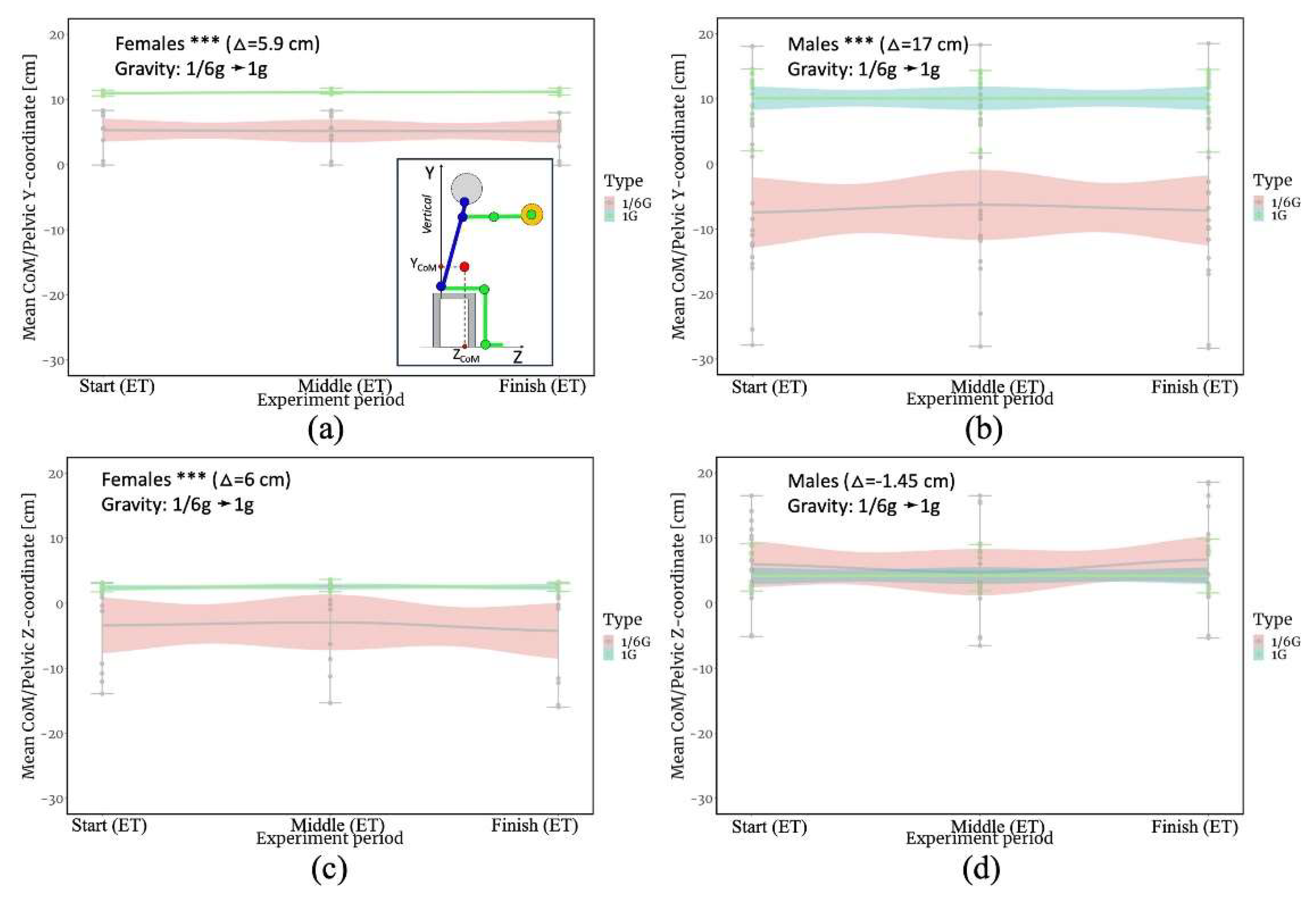Submitted:
13 August 2023
Posted:
14 August 2023
You are already at the latest version
Abstract
Keywords:
1. Introduction
2. Materials and Methods
2.1. Experimental setup
2.3. Statistical methods
| Study variable | Total (N=32) | Male (N=18) | Female (N=14) | p-value | |
| Mean (SD1) | Min/Max | Mean (SD) | Mean (SD) | ||
| Age (year) | 33.59 (8.16) | 25/55 | 34 (9.62) | 33.07 (6.11) | 0.742 |
| Height (m) | 1.75 (0.11) | 1.54/1.95 | 1.83 (0.07) | 1.66 (0.06) | ˂0.001 |
| Body mass (kg) | 71.22 (17.01) | 43.8/114.10 | 82.92 (13.02) | 56.19 (5.95) | ˂0.001 |
| Upper arm (m)2 | 0.34 (0.04) | 0.25/0.40 | 0.35 (0.33) | 0.32 (0.03) | 0.007 |
| Forearm (m)3 | 0.28 (0.03) | 0.20/0.33 | 0.30 (0.02) | 0.25 (0.02) | ˂0.001 |
| Torso volume (dm³) | 37.00 (11.00) | 28.00/61.00 | 44.71 (6.93) | 27.00 (4.42) | ˂0.001 |
| Upper arm volume (dm³) | 2.00 (0.80) | 0.8/3.8 | 2.70 (0.67) | 1.48 (0.38) | ˂0.001 |
| Forearm volume (dm³) | 1.00 (0.30) | 0.4/2.00 | 1.37 (0.20) | 0.72 (0.16) | ˂0.001 |
2.4. CoM assesment
| Gravity | mn1 ET (min) for 1 kg load | mn ET (min) for 3 kg load |
| Static (S) (22 participants) | ||
| 1g | 1.67/0.95 | 0.85/0.34 |
| 1/6g | 7.73/6.21 | 2.65/0.65 |
| Dynamic (D) (25 participants) | ||
| 1g | 1.30/0.80 | 0.79/0.35 |
| 1/6g | 14.93/9.34 | 2.16/0.82 |
- ;
3. Results
4. Discussion
Supplementary Materials
Funding
Institutional Review Board Statement
Informed Consent Statement
Data Availability Statement
Acknowledgments
Conflicts of Interest
References
- Hui, X.; Xiuyuan, Z.; Xuanliang, D.; Donghong, H.; Qin, L.; Hong, L.; Jingmin, L.; Wei, L. A research on the body center of mass of chinese adults. Int. J. Ind. Ergon. 1999, 23, 129–133. [Google Scholar] [CrossRef]
- Faber, G. S.; Chang, C. C.; Kingma, I.; Dennerlein, J. T. Lifting style and participant's sex do not affect optimal inertial sensor location for ambulatory assessment of trunk inclination. Journal of Biomechanics 2013, 46, 1027–1030. [Google Scholar] [CrossRef] [PubMed]
- Huang, C.; Kim, W.; Zhang, Y.; Xiong, S. Development and Validation of a Wearable Inertial Sensors-Based Automated System for Assessing Work-Related Musculoskeletal Disorders in the Workspace. Int. J. Environ. Res. Public Heal. 2020, 17, 6050. [Google Scholar] [CrossRef] [PubMed]
- Conforti, I.; Mileti, I.; Del Prete, Z.; Palermo, E. Measuring Biomechanical Risk in Lifting Load Tasks Through Wearable System and Machine-Learning Approach. Sensors 2020, 20, 1557. [Google Scholar] [CrossRef] [PubMed]
- Ranavolo, A.; Varrecchia, T.; Rinaldi, M.; Silvetti, A.; Serrao, M.; Conforto, S.; Draicchio, F. Mechanical lifting energy consumption in work activities designed by means of the “revised NIOSH lifting equation”. Ind. Heal. 2017, 55, 444–454. [Google Scholar] [CrossRef]
- Mcelhaney, J.H.; Roberts, V.L.; Melvin, J.W.; Shelton, W.; Hammond, A.J. Biomechanics of Seat Belt Design. SAE Transactions 1972, 2873–2885. [Google Scholar] [CrossRef]
- Sonobe, M.; Inoue, Y. Center of Mass Estimation Using a Force Platform and Inertial Sensors for Balance Evaluation in Quiet Standing. Sensors 2023, 23, 4933. [Google Scholar] [CrossRef]
- Landekić, M.; Bačić, M.; Bakarić, M.; Šporčić, M.; Pandur, Z. Working Posture and the Center of Mass Assessment While Starting a Chainsaw: A Case Study among Forestry Workers in Croatia. Forests 2023, 14, 395. [Google Scholar] [CrossRef]
- Ranavolo, A.; Varrecchia, T.; Rinaldi, M.; Silvetti, A.; Serrao, M.; Conforto, S.; Draicchio, F. Mechanical lifting energy consumption in work activities designed by means of the “revised NIOSH lifting equation”. Ind. Heal. 2017, 55, 444–454. [Google Scholar] [CrossRef]
- Kazemi, Z.; Mazloumi, A.; Arjmand, N.; Keihani, A.; Karimi, Z.; Ghasemi, M.S.; Kordi, R. A Comprehensive Evaluation of Spine Kinematics, Kinetics, and Trunk Muscle Activities During Fatigue-Induced Repetitive Lifting. Hum. Factors: J. Hum. Factors Ergon. Soc. 2021, 64, 997–1012. [Google Scholar] [CrossRef]
- ERDMAN, W. S. Center of mass of the human body helps in analysis of balance and movement. MOJ Applied Bionics and Biomechanics 2018, 2, 144–148. [Google Scholar] [CrossRef]
- Sonobe, M.; Inoue, Y. Center of Mass Estimation Using a Force Platform and Inertial Sensors for Balance Evaluation in Quiet Standing. Sensors 2023, 23, 4933. [Google Scholar] [CrossRef] [PubMed]
- Pavei, G.; Seminati, E.; Cazzola, D.; Minetti, A.E. On the Estimation Accuracy of the 3D Body Center of Mass Trajectory during Human Locomotion: Inverse vs. Forward Dynamics. Front. Physiol. 2017, 8, 129. [Google Scholar] [CrossRef]
- McKinon, W.; Hartford, C.; Di Zio, L.; Van Schalkwyk, J.; Veliotes, D.; Hofmeyr, A.; Rogers, G. The agreement between reaction-board measurements and kinematic estimation of adult male human whole body centre of mass location during running. Physiol. Meas. 2004, 25, 1339–1354. [Google Scholar] [CrossRef] [PubMed]
- Dempster, W.T. Space Requirements of the Seated Operator, Geometrical, Kinematic, and Mechanical Aspects of the Body with Special Reference to the Limbs; Michigan State Univ East Lansing: East Lansing, MI, USA, 1955. [Google Scholar]
- Germanotta, M.; Mileti, I.; Conforti, I.; Del Prete, Z.; Aprile, I.; Palermo, E. Estimation of Human Center of Mass Position through the Inertial Sensors-Based Methods in Postural Tasks: An Accuracy Evaluation. Sensors 2021, 21, 601. [Google Scholar] [CrossRef] [PubMed]
- Richmond, S.B.; Fling, B.W.; Lee, H.; Peterson, D.S. The assessment of center of mass and center of pressure during quiet stance: Current applications and future directions. J. Biomech. 2021, 123, 110485. [Google Scholar] [CrossRef]
- Germanotta, M.; Mileti, I.; Conforti, I.; Del Prete, Z.; Aprile, I.; Palermo, E. Estimation of Human Center of Mass Position through the Inertial Sensors-Based Methods in Postural Tasks: An Accuracy Evaluation. Sensors 2021, 21, 601. [Google Scholar] [CrossRef]
- D’andrea, D.; Cucinotta, F.; Farroni, F.; Risitano, G.; Santonocito, D.; Scappaticci, L. Development of Machine Learning Algorithms for the Determination of the Centre of Mass. Symmetry 2021, 13, 401. [Google Scholar] [CrossRef]
- Corazza, S.; Andriacchi, T.P. Posturographic analysis through markerless motion capture without ground reaction forces measurement. J. Biomech. 2009, 42, 370–374. [Google Scholar] [CrossRef]
- Warburton, D. E.; Jamnik, V.; Bredin, S. S.; Shephard, R. J.; Gledhill, N. The 2020 Physical Activity Readiness Questionnaire for Everyone (PAR-Q+) and electronic Physical Activity Readiness Medical Examination (ePARmed-X+): 2020 PAR-Q+. The Health & Fitness Journal of Canada 2019, 12, 58–61. [Google Scholar] [CrossRef]
- Volkova, T.; Nicollier, C.; Gass, V. An Empirical and Subjective Model of Upper Extremity Fatigue Under Hypogravity. Front. Physiol. 2022, 13, 832214. [Google Scholar] [CrossRef]
- Volkova, T. Biomechanics at the workplace under hypogravity conditions; EPFL: Lausanne, Switzerland, 2022. [Google Scholar]
- Github CVLab. Available online: https://github.com/cvlab-epfl/multiview_calib (accessed on 1 June 2018).
- Simon, T.; Joo, H.; Matthews, I.; Sheikh, Y. Hand keypoint detection in single images using multiview bootstrapping. In Proceedings of the IEEE conference on Computer Vision and Pattern Recognition, Honolulu, HI, USA, 21-26 July 2017. [Google Scholar]
- Cao, Z.; Simon, T.; Wei, S. E.; Sheikh, Y. Realtime multi-person 2d pose estimation using part affinity fields. In Proceedings of the IEEE conference on computer vision and pattern recognition, Honolulu, HI, USA, 21-26 July 2017; pp. 7291–7299. [Google Scholar]
- Wei, S. E.; Ramakrishna, V.; Kanade, T.; Sheikh, Y. Convolutional pose machines. computer vision and pattern recognition (cvpr). 2016 IEEE Conference on.
- Volkova, T.; Nicollier, C.; Gass, V. Markerless motion capture method application for investigation of joint profiles in the workplace under simulated hypogravity. 2021. [Google Scholar]
- Warburton, D. E.; Jamnik, V.; Bredin, S. S.; Shephard, R. J.; Gledhill, N. The 2020 physical activity readiness questionnaire for everyone (PAR-Q+) and electronic physical activity readiness medical examination (ePARmed-X+): 2020 PAR-Q+. The Health & Fitness Journal of Canada 2019, 12, 58–61. [Google Scholar] [CrossRef]
- Bachmann, R.; Sporri, J.; Fua, P.; Rhodin, H. Motion Capture from Pan-Tilt Cameras with Unknown Orientation. 2019, 308–317. [Google Scholar] [CrossRef]
- Harris, L. R. The Perception of Self-Orientation. In Oxford Research Encyclopedia of Psychology; 2022. [Google Scholar]
- Clark, T.K.; Young, L.R. A Case Study of Human Roll Tilt Perception in Hypogravity. Aerosp. Med. Hum. Perform. 2017, 88, 682–687. [Google Scholar] [CrossRef]
- STATISTICAL COHEN, J. Analysis Power. Current Directions in Psychological Science 1992, 1, 98–101. [Google Scholar] [CrossRef]


Disclaimer/Publisher’s Note: The statements, opinions and data contained in all publications are solely those of the individual author(s) and contributor(s) and not of MDPI and/or the editor(s). MDPI and/or the editor(s) disclaim responsibility for any injury to people or property resulting from any ideas, methods, instructions or products referred to in the content. |
© 2023 by the authors. Licensee MDPI, Basel, Switzerland. This article is an open access article distributed under the terms and conditions of the Creative Commons Attribution (CC BY) license (http://creativecommons.org/licenses/by/4.0/).





